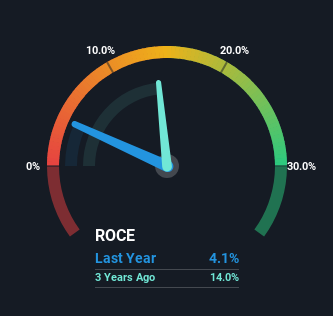- Israel
- /
- Household Products
- /
- TASE:ALBA
The Returns On Capital At Albaad Massuot Yitzhak (TLV:ALBA) Don't Inspire Confidence
If we're looking to avoid a business that is in decline, what are the trends that can warn us ahead of time? More often than not, we'll see a declining return on capital employed (ROCE) and a declining amount of capital employed. This combination can tell you that not only is the company investing less, it's earning less on what it does invest. So after we looked into Albaad Massuot Yitzhak (TLV:ALBA), the trends above didn't look too great.
Return On Capital Employed (ROCE): What Is It?
If you haven't worked with ROCE before, it measures the 'return' (pre-tax profit) a company generates from capital employed in its business. The formula for this calculation on Albaad Massuot Yitzhak is:
Return on Capital Employed = Earnings Before Interest and Tax (EBIT) ÷ (Total Assets - Current Liabilities)
0.041 = ₪28m ÷ (₪1.6b - ₪887m) (Based on the trailing twelve months to June 2023).
Therefore, Albaad Massuot Yitzhak has an ROCE of 4.1%. In absolute terms, that's a low return and it also under-performs the Household Products industry average of 9.9%.
Check out our latest analysis for Albaad Massuot Yitzhak

Historical performance is a great place to start when researching a stock so above you can see the gauge for Albaad Massuot Yitzhak's ROCE against it's prior returns. If you want to delve into the historical earnings, revenue and cash flow of Albaad Massuot Yitzhak, check out these free graphs here.
What Does the ROCE Trend For Albaad Massuot Yitzhak Tell Us?
The trend of ROCE at Albaad Massuot Yitzhak is showing some signs of weakness. Unfortunately, returns have declined substantially over the last five years to the 4.1% we see today. What's equally concerning is that the amount of capital deployed in the business has shrunk by 29% over that same period. The fact that both are shrinking is an indication that the business is going through some tough times. If these underlying trends continue, we wouldn't be too optimistic going forward.
While on the subject, we noticed that the ratio of current liabilities to total assets has risen to 56%, which has impacted the ROCE. If current liabilities hadn't increased as much as they did, the ROCE could actually be even lower. What this means is that in reality, a rather large portion of the business is being funded by the likes of the company's suppliers or short-term creditors, which can bring some risks of its own.
What We Can Learn From Albaad Massuot Yitzhak's ROCE
In short, lower returns and decreasing amounts capital employed in the business doesn't fill us with confidence. Unsurprisingly then, the stock has dived 71% over the last five years, so investors are recognizing these changes and don't like the company's prospects. With underlying trends that aren't great in these areas, we'd consider looking elsewhere.
One more thing: We've identified 4 warning signs with Albaad Massuot Yitzhak (at least 2 which are potentially serious) , and understanding them would certainly be useful.
For those who like to invest in solid companies, check out this free list of companies with solid balance sheets and high returns on equity.
New: Manage All Your Stock Portfolios in One Place
We've created the ultimate portfolio companion for stock investors, and it's free.
• Connect an unlimited number of Portfolios and see your total in one currency
• Be alerted to new Warning Signs or Risks via email or mobile
• Track the Fair Value of your stocks
Have feedback on this article? Concerned about the content? Get in touch with us directly. Alternatively, email editorial-team (at) simplywallst.com.
This article by Simply Wall St is general in nature. We provide commentary based on historical data and analyst forecasts only using an unbiased methodology and our articles are not intended to be financial advice. It does not constitute a recommendation to buy or sell any stock, and does not take account of your objectives, or your financial situation. We aim to bring you long-term focused analysis driven by fundamental data. Note that our analysis may not factor in the latest price-sensitive company announcements or qualitative material. Simply Wall St has no position in any stocks mentioned.
About TASE:ALBA
Albaad Massuot Yitzhak
Manufactures and sells wet wipes and feminine hygiene products worldwide.
Good value with proven track record.
Market Insights
Community Narratives



